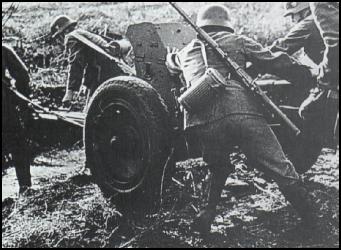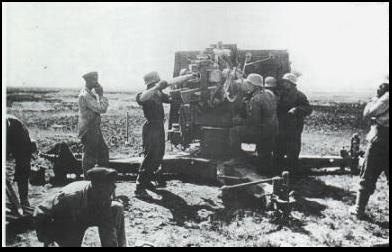Panzerabwehrkanone
German Artillery
|
|
|
Panzerabwehrkanone [ Mike Kaspar ] Just as every German tank was a Tiger for many Allied
soldiers so every anti-tank gun was an 'Eighty Eight'.One
of the great artillery weapons of all time the 8.8-cm anti-aircraft gun was
certainly a tank killer of note.But it was not the
only such weapon in the Wehrmacht's armory,not even the most numerous. |
|
|
|
Anti-tank company on the drill field |
|
Pak 37mm Anti-Tank Gun |
|||
|
Shell |
Weight |
Muzzle Velocity |
Penetration |
|
Anti-tank |
0.69 kg |
745 meters/sec |
36mm at 500 meters |
|
Anti-personnel |
0.65 kg |
745 meters/sec |
Infantry targets only |
|
Hard-core |
0.35 kg |
1030 meters/sec |
50mm at 500 meters |
|
In the last peacetime year the German Army had 51 anti-tank
units
which were except for the one anti-tank training unit stationed in
Wünsdorf near Berlin , divided among the divisions.Their numbers of
37mm Pak guns were as follows :
An anti-tank unit normally consisted of a staff , three
companies and a replacement company with 22 officers , three officials
, 132 non-commissioned officers and551 enlisted men.Their motor vehicles
were : 45 personnel vehicles , 91 trucks , 78 motorcycles , 46 with
sidecars.When World War II began and new divisions were established
the field army as of September 1st 1939 numbered 23,029 officers ,
non-commissioned officers and enlisted men in the anti-tank units
, and the replacement army numbered 16,353 men.In the winter of 1939-40
personnel was increased. |
|
|
|
The standard German anti-tank gun at the outbreak of war
was the 3.7cm PaK35.Designed in the 1920s it was a light and handy
weapon , though in 1940 its crews found that it could not deal with
the thick armour of British and French infantry tanks. |
|
|
|
|
|
The key to the success of the Eighty-Eight
was the very high velocity of its shells.It
could damage most Allied tanks even when firing high explosive rounds
and with armour-piercing shot it was lethal.Curiously
the German were the only nation which used heavy dual-purpoe
weapons : most Allied armies had comparable anti-aircraft guns but
these were never used to engage ground targets. |
|
Infantry Weapons German infantry entered the war with two 7.92mm anti-tank
rifles the PzB 38 and PzB
39 , however along with the 20mm PzB 41 they were
not effective against the thicker armour of modern tanks.There was even a small shaped charge projectile
which could be fired from the Walther 27mm flare pistol , though it was
described as "very much a last ditch inaccurate and ineffective weapon".In 1942 however they received the Panzerfaust or 'armored fist'.This
one shot hollow charge rocket propelled anti-tank weapon was designed by Dr
Heinrich Langweiller at Hugo Schneider AG. Langweiller improved the design which initially had an
effective range of only 30 metres.By the end of the
war the Panzerfaust 100 could hit tanks at 100 metres.The shaped charge warhead of the Panzerfaust 30 could penetrate 140mm of armour.Later versions with 150mm diameter warheads could
penetrate 200mm at a range of 80 metres.For many
Soviet and Allied tank crews the greatest fear was the determined Panzerfaust-armed German infantryman lurking in the ruins
or vegetation close to a track or road.The Germans
recognized this type of cool courage with special tank destruction badges. |



